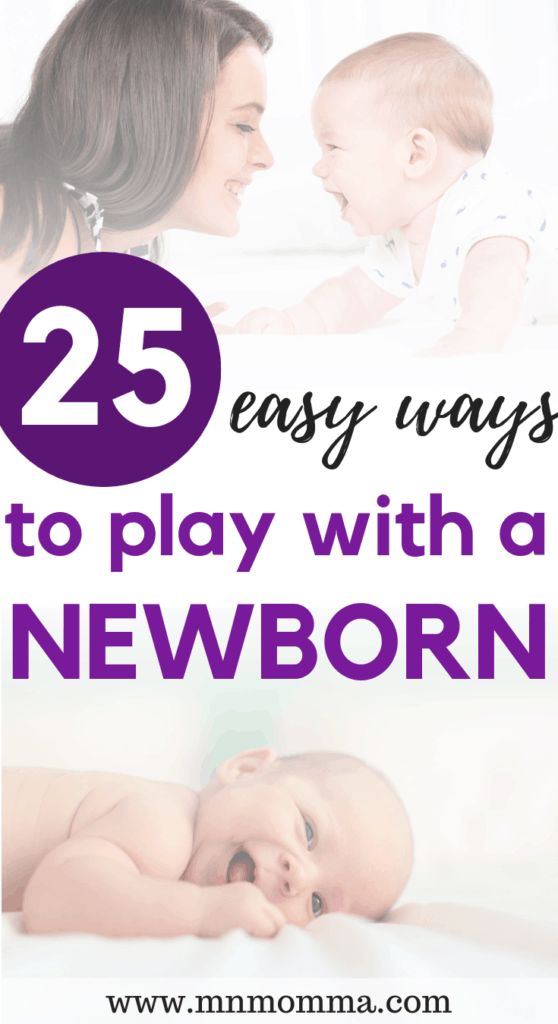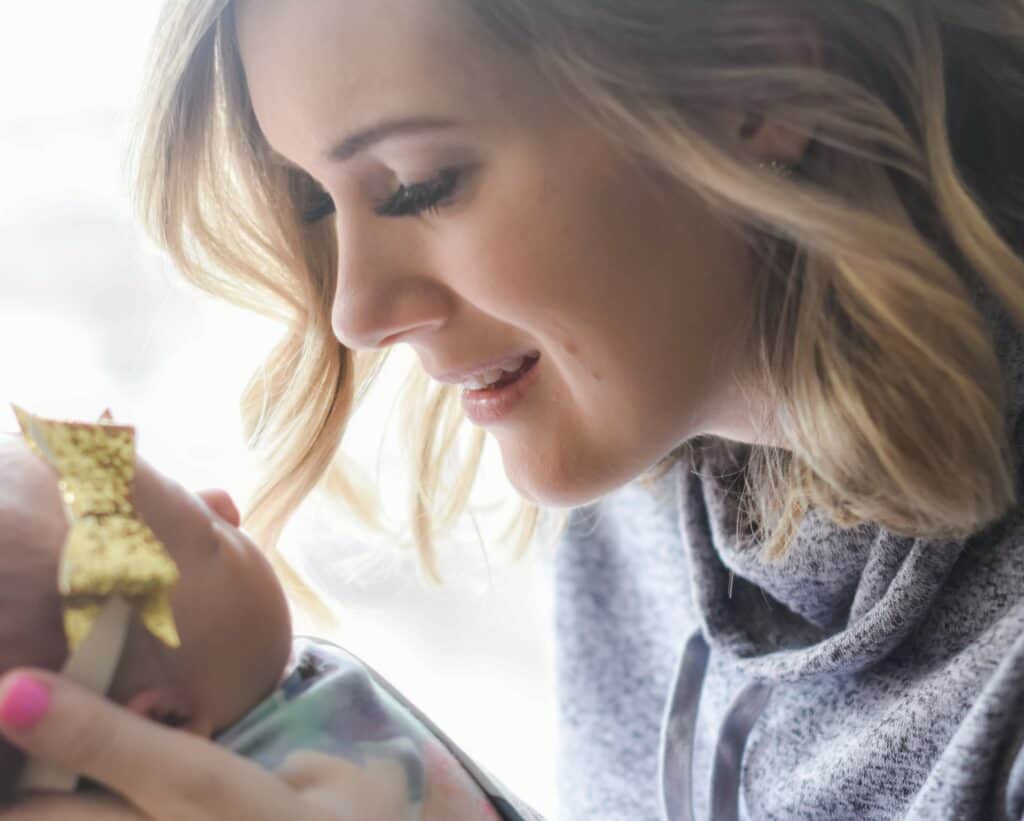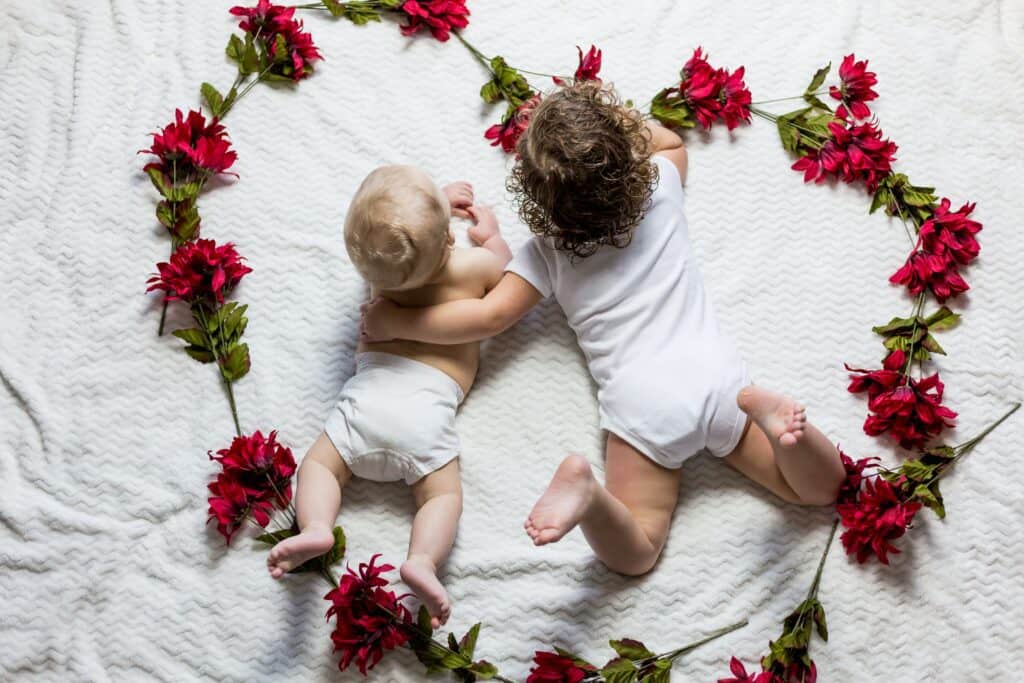25 Ways To Play with Your New Baby! (Baby Activities for 0-3 months)
Disclosure: This post may contain affiliate links, which means I may receive a small commission if you click a link and purchase something. Please check out my disclosure policy for more details. All opinions are my own!

Congratulations! You have a brand new baby that you’re figuring out how to feed, change, get to sleep, and keep happy.
But now you’re left wondering, how do I actually play with my newborn baby?
Learning the ways to play with your 0-3 month old baby isn’t one of the first things they teach you when they hand you your newborn, am I right?
Here’s some idea of the best activities you can do with your new baby.
Know What Your Baby Can Do At 0-3 Months Old
Let’s be honest here:
Newborns have some serious limitations when it comes to play time, especially in those first few weeks.
So before we get into all the fun things you can actually do with your newborn baby, let’s talk about what you need to be able to expect from them according to the Mayo Clinic.
What Your Infant Can’t Do Yet:
- Hold his/her head steady (it will come, it’s just going to go through a wobbly stage for awhile!)
- Baby’s early vision isn’t great. But as time goes by it greatly improves!
- 1 month: baby likes bold patterns in sharply contrasting colors or black-and-white; they can also typically see about 8-10 inches in front of them (about this distance from their face to their mother’s during breastfeeding!)
- 2 months: eyes become more coordinated and may track objects
- 3 months: can spot similar faces, even from across the room
What Your Infant CAN Do (0-3 months):
NOTE: these will vary with your child’s development
- Lift his/her head while on his/her tummy. Your baby will get better at this as they grow, but many newborns can lift and turn their heads very early in life.
- Baby can hear you! Just because your baby may not see very well yet, doesn’t mean baby’s senses aren’t active. Expect responses to your voice/loud noises!
- Baby will eventually smile/giggle/coo as though he or she is talking to you
- Grasp your fingers or a toy – even for just a few seconds. Keep in mind, an older baby will have better developed hand-eye coordination, but if you’re ever nervous consult your doctor or occupational therapist to discuss baby’s development and for any medical advice.

<— Pin it now! Don’t have time to read it all? Save it for later!
25 Best Ways to Play With Your 0-3 Month Old Baby

1. Sing to your baby and move his/her arms and legs to “dance”
Grab your phone or ask Alexa to play your favorite songs and nursery rhymes (or sing your own!) – then help your baby dance! Move her arms and legs to the rhythm. Plus, there’s a good chance all that talking and singing will only enhance baby’s language development.
An alternative is to play patty-cake or the itsy bits spider and help move baby’s arms to create the actions.
2. Hold your baby and dance together
More music! Whether Alexa is playing or you’re singing, a great way to bond with your baby is to hold your baby close and dance.
Switch things up from slow to fast songs, just don’t get too wild with your little one!
3. Have a conversation using exaggerated expressions
Your baby absolutely loves you and one of the best thing you can do is to start talking! Chat away with your little one to start developing the idea of language right away.
Using different facial expressions, or varying your voice, can help keep your baby super interested.
4. Read to your baby using different voices and expressions

I had a hard time with this one at first, since it seemed silly to read to your newborn who can’t see more than a foot in front of him!
BUT, all the research points to how important and what a great activity reading is, even early on, so you better believe we read!
Grab a book with contrasting colors (think black and white, or bright opposites – this one has both!) and read!
If you don’t have a book like that, grab a regular children’s book and be sure you use different voices and expressions. Your baby will love the variety.
5. During tummy time, lay next to your baby and encourage him or her

“Woohoo! You can do it!” “That’s my girl!” – These are all things you can hear us cheering to our infant during tummy time.
While baby may not know what you’re saying, this helps encourage social skills and family bonding (even our toddler helps cheer!).
To add an extra piece of fun to the mix, lay down next to baby so she’s not doing tummy time alone. We like to encourage our toddler to “teach her how to do it!”. Tummy time helps build neck muscles, create body awareness, and improve gross motor skills even for a one-month-old baby. It’s great if you can add this to your daily routines.
6. During tummy time, grab a rattle, book, or other toy and lay it in front of your baby

If your baby hates tummy time (trust me, I know it happens, mine BOTH hated tummy time), grab a rattle or toy to set in front of baby to peak his interest.
You can play with it in front of your baby’s visual field, or you can just set it down and let your baby study it.
The current favorites to look at for our baby are:
- These wooden dolls from a Melissa and Doug toy we have
- A book with bright pictures set up for her to see – we LOVE this baby proof one!
7. Lay on your back, with baby on your chest on his/her belly for a different take on tummy time
While your baby may not be able to see very far, very clearly yet, there’s one thing she does love – your face!
Laying on your back and placing your baby on your chest, gives your baby a new perspective on tummy time (and gives YOU a great chance for cuddle time!).
8. Lay baby on his/her back and touch different body parts – naming them or making a fun noise as you touch them
“Boop!” “Whoop!”
Try any fun noise you can think of and use it while touching different body parts. (Ex: touch baby’s belly – “boop!”, then touch baby’s nose – “boop!”)
Your baby will begin to anticipate your silly noises and may even start to giggle about it.
To switch things up, you can also name the body part as you touch it, helping enhance baby’s language.
9. Let baby look in the mirror

Can you imagine not knowing what a mirror does, and seeing someone who looks just like you?!
A mirror is so much fun for a baby and helps to capture his attention in a new way!
From simply studying that baby in the mirror to seeing his expressions, your baby will love it!
Side note: make sure you have a mirror that’s safe for babies! We love this one, but also have one attached to our play mat!
10. Look at picture books with high contrasting colors or patterns

Take the time to look at picture books with your baby. Showing her high contrasting images will help keep her interested and can help develop her eyesight!
So what are high contrasting images?
Think black and white, or bright colors.
Parents.com has free set of printable high contrast pictures if you don’t have any and want to print some right now!
11. Take baby on a walk and talk about everything you see
Load baby up in your favorite stroller and take her for a walk to get some fresh air and spend some time talking.
Talk about everything you see, point out the trees, the sky, the birds, the cars.
Talk about it all!
If you feel like you don’t have more to say, try explaining what kind of tree it is, what it looks like, how trees provide shade, and on and on and on…
Are you a talker?
If so, this one will be super easy!
If not, it can be a little hard to talk and have no one response back – but I promise! The more you do it, the easier it gets.
12. Shake a rattle toy on one side of baby’s head and see if they turn toward it

Buy this rattle now on Amazon!
This is a fun time to start testing baby’s milestones and developments.
Simply grab a rattle (if you don’t have one yet, this one is super reasonably priced and arrives in 2 days!), and shake it to the side of your baby’s head.
See if he turns to find the sound!
13. Show baby a toy and slowly move it from side to side or up and down
Here’s another great way to test your baby’s development!
Grab a rattle or other toy that your baby can easily see, and move it up and down or from side to side. Watch and see if your baby follows the toy!
Note: if she doesn’t follow the toy yet, give it a week and try again! Don’t forget that all babies develop at their own pace.
14. Tie a balloon to your baby’s foot and let them kick!
This is one of my favorite ways to play with a young baby!
Grab a helium balloon (your dollar store probably has some!), and loosely tie it to your baby’s foot. Let him kick and watch the balloon move and float.
15. Prop baby up on a boppy pillow for a new view during tummy time

Ready for another tummy time idea?
Prop your baby up on a boppy pillow to give her a new view during tummy time.
I like to combine this young baby activity with adding a few toys in front of her to help keep her busy (with something other than being on her tummy!).
16. Place baby on an activity mat

Buy this activity mat on Amazon!
This one is pretty simple, but another one of our favorites because our baby loves it.
Place your baby on an activity mat and let her kick, reach, and look at all the toys hanging above her. As she nears closer to 4 months, she may even start to reach for objects and begin working on more fine motor skills.
Here’s the new version of the one our baby really likes with lots of colorful toys – it’s also held up perfectly for two babies!
17. Hold your baby in an outward position and walk or bounce
Play with your new baby by walking around or bouncing your baby in an outward position.
This lets your baby see the world from a new view than he’s used to.
18. Go to the side of your baby and talk to him or her, see if he/she will turn their head to see you
Similar to using a noisy toy, talk or sing to your baby on one side of her head.
See if she turns to look at you!
19. Give baby kisses and say “got you!” – this becomes a fun game of anticipation for them

This game is fun an interactive for your new baby, while also giving you a great opportunity to bond and show your little one love!
Give your baby kisses on the cheek, belly, arm, or feet and say “got you!” each time. Your baby will anticipate the kisses and fun “got you!” phrase.
20. Let baby kick a noise making toy (piano), tissue paper, or cookie sheet
Another way to let your 0-3 month old play is by giving him something to spark more than once sense at once.
In this case: touch and hearing.
Lay your baby on his back and set up a baby safe household object or toy for him to kick at. Make sure the object won’t fall on your baby when it’s kicked.
Here’s some ideas:
- a play mat that has a noise maker attached (i.e. piano)
- tissue paper
- cookie sheet
21. Try sticking your tongue out at baby and see if she imitates you!
Play a round of copy cat and make silly faces at your baby!
Try sticking your tongue out, copying your baby’s coos, and making other fun sounds to see if your baby copies you.
You can also switch it around and copy your baby’s actions! This way you know baby is capable of doing the action, and may be more likely to copy you!
22. Touch baby’s hands and feet with different textures

Buy this touch and feel book on Amazon!
Let your baby experience her sense of touch! Try touching your baby’s hands and feet (or belly or cheek!) with a touch and feel book, or different textured objects.
Try these:
- feathers
- cotton ball
- bumpy ball
Note: make sure you never leave baby alone with any objects that are not baby safe
23. Cycle baby’s legs (helps with gas too!)
Looking for a fun baby activity for your 0-3 month old? Start cycling those little legs like a bike! Diaper changes are a great time to try this fun activity with your 1-month-old baby (older babies likes bicycles too ;))
It’s a fun way to move baby’s body, give them a nice stretch, and as a bonus:
if your baby’s gassy or uncomfortable – this new baby activity can work wonders!
24. Blow bubbles

Blowing bubbles, this is probably a baby activity for a 3 month old as opposed to a fresh, brand new, newborn.
Blow bubbles in front of your baby, or even at your baby’s feet to spark a sensory reaction! Sensory play is great for brain development and helping your baby learn more about the world.
Let’s face if bubbles are fun for all kids and are something you probably already have lying around if you have other children.
If not, you can grab them for cheap at a dollar store or online.
25. Hold baby up to “walk”, “stand”, and “jump”
As your baby gets closer to 3 months, she’ll probably start to gain better head control and may even be itching to bear some weight.
While I certainly don’t suggest you let your baby do ANY of these on their own, she just might love getting the chance to “stand” or “jump” in your lap with your help.

Growth Spurts and Development
It’s important to remember that you’re going through an exciting time with your baby. Besides getting to know each other better, your baby is growing and changing every day.
During the first 3 months, your baby will go through a growth spurt at about 2-3 weeks, 6 weeks and 3 months. This is where things can get really fun and you can learn new ways to interact with your baby as they develop new skills.
Note: you might also notice your baby wanting to eat ALL the time during this time, especially if you’re breastfeeding and giving baby breast milk. Just keep up the hard work, this growth spurt will pass and baby will likely have some fun new skills to show off.
Related: How To Teach Your Baby Sign Language (And Why You’ll Want To!)
Relate: How to Survive Your Baby’s 1st Cold
Fun Things To Do With Your New Baby
First and foremost, make sure your baby is always safe. After that, these activities can be fun and help keep you and your baby try new things and give you a chance to continue to bond.














